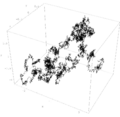Brownian motion facts for kids
Brownian motion is the jiggling, random movement of tiny particles in a liquid or a gas. Imagine dust motes dancing in a sunbeam – that's a bit like it! This motion happens because super-fast atoms or molecules in the liquid or gas keep bumping into the particles.
A scientist named Robert Brown first noticed this strange movement in 1827. He was looking at pollen grains in water under a microscope. He saw tiny bits inside the pollen moving around, but he didn't know why.
Later, in 1905, the famous scientist Albert Einstein explained it. He showed that the movement was caused by individual water molecules hitting the pollen particles. This was a big step in proving that atoms and molecules really exist! Another scientist, Jean Baptiste Perrin, later proved Einstein's ideas with experiments in 1908. Perrin even won the Nobel Prize in Physics in 1926 for his work.
The tiny bumps from atoms and molecules come from all directions. But sometimes, a particle gets hit more on one side than another. This makes it move in a random, unpredictable way.
History of Brownian Motion Discovery
The idea of tiny, moving particles goes way back! The Roman writer Lucretius described something similar around 60 BC. In his poem "On the Nature of Things", he wrote about dust particles dancing in sunlight. He used this to suggest that atoms exist.
While others like Jan Ingenhousz saw similar motions in the late 1700s, the official discovery is usually given to the botanist Robert Brown. In 1827, Brown was studying pollen grains from a plant called Clarkia pulchella in water. He saw tiny particles, which came from the pollen, moving in a shaky way. He tried the experiment with non-living things too. This showed that the movement wasn't caused by life itself, but he still didn't know its true cause.
The first person to describe the math behind this motion was Thorvald N. Thiele in 1880. Later, in 1900, Louis Bachelier used it to study how stock markets behave.
It was Albert Einstein in 1905 and Marian Smoluchowski in 1906 who truly explained Brownian motion to other scientists. They showed how it could help prove that atoms and molecules exist. Their ideas were then confirmed by the experiments of Jean Baptiste Perrin in 1908.
Images for kids

See also
 In Spanish: Movimiento browniano para niños
In Spanish: Movimiento browniano para niños







